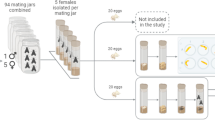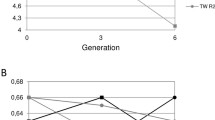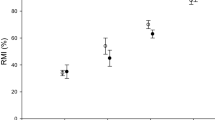Abstract
Quantitative genetic studies for life history and behavioral traits are important in quality control for insect mass-rearing programs. Firstly, a brief history of quality control in mass-reared insects is described. Next, the differentiation of many traits of wild and mass-reared melon flies,Bactrocera cucurbitae, in Okinawa is reviewed, and the factors which have caused variation in these traits are considered. As artificial selection pressures are thought to be more important than inbreeding depression and genetic drift in the mass-reared strain of the Okinawan melon fly, two artificial selection experiments were conducted to evaluate genetic variations and genetic correlations among life history and behavioral traits. These are divergent selections for age at reproduction and for developmental period. The genetic relationship among 5 traits, i.e. longevity, age at reproduction, developmental period, circadian period, and time of mating was clarified and discussed in relation to genetic changes of traits during the mass-rearing. The results suggest that the genetic trade-off relationships between traits should be taken into account in mass-rearing programs.
Similar content being viewed by others
References
Aluja, M. and P. Liedo (1993)Fruit flies, biology and management. Springer-Verlag, New York.
Baumhover, A. H., C. N. Husman and A. J. Graham (1966) Screwworm, pp. 533–554.In C. N. Smith (ed.)Insect colonization and mass-production. Academic Press, New York.
Becker, W. A. (1992)Manual of quantitative genetics, 5th edn. Academic Enterprises, Pullman, Washington.
Bell, G. and V. Koufopanou (1986) The cost of reproduction.Oxford Survey in Evolutionary Biology 3: 83–131.
Boake, C. R. B. (1994)Quantitative genetic studies of behavioral evolution. The University of Chicago Press, Chicago.
Boiler, E. F. (1972) Behavioural aspects of mass-rearing of insects.Entomophaga 17: 9–25.
Bulmer, M. G. (1980)The mathematical theory of quantitative genetics. Clarendon Press, Oxford.
Calkins, C. O. (1989) Quality control, pp. 153–162.In A. S. Robinson and G. Hooper (eds.)Fruit flies their biology, natural enemies and control Vol. 3B. Elsevier, Oxford.
Calkins, C.O., K. Bloem, S. Bloem and D. L. Chambers (1994) Advances in measuring quality and assuring good field performance in mass reared fruit flies, pp. 85–96.In C. O. Calkins, W. Klassen and P. Liedo (eds.)Fruit flies and the sterile insect technique. CRC Press, Boca Raton.
Chambers, D. L. (1977) Quality control in mass rearing.Annual Review of Entomology 22: 289–308.
Crow, J. F. and M. Kimura (1970)An introduction to population genetics theory. Harper and Row, New York.
Falconer, D. S. (1989)An introduction to population genetics, 3rd edn. Longman, London.
Finney, G. L. and T. W. Fisher (1964) Culture of entomophagous insects and their hosts, pp. 328–355.In P. DeBach and E. T. Schlinger (eds.)Biological control of insect pests and weeds. Chapman and Hall, London.
Grafen, A. (1990) Do animals really recognize kin?Animal Behavior 39: 42–54.
Halliday, T. and S. J. Arnord (1986) Multiple mating by female: a perspective from quantitative genetics.Animal Behavior 35: 939–941.
Hendrichs, J.,G. Franz and P. Rendon (1995) Increased effectiveness and applicability of the sterile insect technique through maleonly release for control of Mediterranean fruit flies during fruiting seasons.Journal of Applied Entomology 119: 371–377.
Hill, W. G. (1982) Predictions of response to artificial selection from new mutations.Genetical Research, Cambridge 40: 255–278.
Hoffmann, A. A. and Z. Cacoyianni (1989) Selection for territoriality inDrosophila melanogaster: correlated responses in mating success and other fitness components.Animal Behavior 38: 23–34.
Hoffmann, A. A. and P. A. Parsons (1991)Evolutionary genetics and environmental stress. Oxford University Press, Oxford.
Itô, Y. and H. Kakinohana (1995) Eradication of the melon fly (Diptera: Tephritidae) from the Ryukyu Archipelago with the sterile insect technique: possible reasons for its success. pp. 215–230.In J. G. Morse, R. L. Metcalf, J. R. Carey and R. V. Dowell (eds.)The Mediterranean fruit fly in California: defining critical research. University of California, California.
Itô, Y., M. Yamagishi and H. Kuba (1993) Mating behaviour of the melon fly: sexual selection and sperm competition. pp. 441–452.In IAEA (ed.)Management of insect pest: nuclear and related molecular and genetic techniques. IAEA, Vienna.
Iwahashi, O., Y. Itô and M. Shiyomi (1983) A field evaluation of the sexual competitiveness of sterile melon flies,Dacus (Zeugodacus) cucurbitae.Ecological Entomology 8: 43–48.
Jamieson, I. G. (1989) Behavioral heterochrony and the evolution of birds’ helping at the nest: an unselected consequence of communal breeding?American Naturalist 133: 394–406.
Kakinohana, H. (1980) Qualitative changes in the mass reared melon fly,Dacus cucurbitae Coq. pp. 27–36.In NIAS (National Institute of Agricultural Sciences) (ed.)Fruit fly problems (Proceedings of the Symposium Kyoto and Naha, 1980). National Institute of Agricultural Science, Yatabe, Ibaraki.
Kakinohana, H. (1996) Studies on the mass production of the melon flies,Bactrocera cucurbitae Coquillett.Bulletin of the Okinawa Agricultural Experiment Station 16: 1–102 (in Japanese with English summary).
Kakinohana, H. and M. Yamagishi (1991) The mass production of the melon fly techniques and problems. pp. 1–10.In K. Kawasaki, O. Iwahashi and K. Kaneshiro (eds.)Biology and control of fruit flies (Proceedings of the International Symposium, Okinawa, 1991). Ginowan, Okinawa.
Kakinohana, H., H. Soemori and H. Nakamori (1977) Dispersal ability of mass-reared melon fly adults under field conditions.Report of the Eradication Program of the Melon Fly in Okinawa Prefecture 3: 23–24 (in Japanese).
Kakinohana, H., H. Kuba, T. Kohama, K. Kinjo, M. Taniguchi, H. Nakamori, A. Tanahara and Y. Sokei (1997) Eradication of the melon fly,Bactrocera cucurbitae (Coquillett), by mass release of sterile flies in Okinawa Prefecture, Japan.JARQ — Japan Agricultural Research Quarterly 31: 91–100.
Kirkpatrick, M. and M. J. Ryan (1991) The evolution of mating preference and the paradox of the lek.Nature 350: 33–38.
Klassen, W., D. A. Lindquist and E. J. Buyckx (1994) Overview of the joint FAO/IAEA division’s involvement in fruit fly sterile insect technique programs. pp. 3–26.In C.O. Calkins, W. Klassen and P. Liedo (eds.)Fruit flies and the sterile insect technique. CRC Press, Boca Raton.
Knipling, E. F. (1955) Possibilities of insect control or eradication through the use of sexual sterile males.Journal of Economic Entomology 48: 459–462.
Knipling, E. F. (1966) Introduction. pp. 2–12.In C. N. Smith (ed.)Insect colonization and mass production. Academic Press, New York.
Koyama, J., H. Nakamori and H. Kuba (1986) Mating behavior of wild and mass-reared strains of the melon fly,Dacus cucurbitae Coquillett (Diptera: Tephritidae), in a field cage.Applied Entomology and Zoology 21: 203–209.
Kuba, H. and J. Koyama (1982) Mating behaviour of the melon fly,Dacus cucurbitae Coquillett (Diptera: Tephritidae): comparative studies of one wild and two laboratory strains.Applied Entomology and Zoology 17: 559–568.
Kuba, H. and H. Soemori (1988) Characteristics of copulation duration, hatchability of eggs and remating intervals in the melon fly,Dacus cucurbitae Coquillett (Diptera: Tephritidae).Japanese Journal of Applied Entomology and Zoology 32: 321–324 (in Japanese with English summary).
Kuba, H. and Y. Sokei (1988) The production of pheromone clouds by spraying in the melon fly,Dacus cucurbitae Coquillett (Diptera: Tephritidae).Journal of Ethology 6: 105–110.
Kuba, H., J. Koyama and R. J. Prokopy (1984) Mating behavior of wild melon flies,Dacus cucurbitae Coquillett (Diptera: Tephritidae) in a field cage: distribution and behavior of flies.Applied Entomology and Zoology 19: 367–373.
Kuba, H., T. Kohama, H. Kakinohana, M. Yamagishi, K. Kinjo, Y. Sokei, T. Nakasone and Y. Nakamoto (1996) The successful eradication programs of the melon fly in Okinawa. pp. 543–550.In B. A. McPheron and G. J. Steck (eds.)Fruit fly pests: a world assessment of their biology and management. St. Lucie Press, Delray Beach, Florida.
Leppla, N. C. (1989) Laboratory colonization of fruit flies. pp. 91–103.In A. S. Robinson and G. Hooper (eds.)Fruit flies their biology, natural enemies and control Vol. 3B. Elsevier, Oxford.
Mackauer, M. (1972) Genetic aspects of insect production.Entomophaga 17: 27–48.
Mackauer, M. (1976) Genetic problems in the production of biological control agents.Annual Review of Entomology 21: 369–385.
Mayr, E. (1954) Change of genetic environment and evolution. pp. 157–180.In J. Huxley, A. C. Hardy and E. B. Ford (eds.)Evolution as process. Macmilliam, New York.
Miyatake, T. (1993) Difference in the larval and pupal periods between mass-reared and wild strains of the melon fly,Bactrocera cucurbitae (Coquillett) (Diptera: Tephritidae).Applied Entomology and Zoology 28: 577–581.
Miyatake, T. (1995) Two-way artificial selection for developmental period inBactrocera cucurbitae (Diptera: Tephritidae).Annals of the Entomological Society of America 88: 848–855.
Miyatake, T. (1996a) Artificial selection experiments in the melon fly: the status quo and problems. pp. 437–443.In B. A. McPheron and G. J. Steck (eds.)Fruit fly pests: a world assessment of their biology and management. St. Lucie Press, Delray Beach, Florida.
Miyatake, T. (1996b) Comparison of adult life history traits in lines artificially selected for long and short larval and pupal developmental periods in the melon fly,Bactrocera cucurbitae (Diptera: Tephritidae).Applied Entomology and Zoology 31: 335–343.
Miyatake, T. (1997a) Genetic trade-off between early fecundity and longevity inBactrocera cucurbitae (Diptera: Tephritidae).Heredity 78: 93–100.
Miyatake, T. (1997b) Correlated responses to selection for developmental period inBactrocera cucurbitae (Diptera: Tephritidae): time of mating and daily activity rhythms.Behavior Genetics 27: 489–498.
Miyatake, T. and D. Haraguchi (1996) Mating success inBactrocera cucurbitae (Diptera: Tephritidae) under different rearing densities.Annals of the Entomological Society of America 89: 284–289.
Miyatake, T. and T. Shimizu (1999) Genetic correlations between life-history and behavioral traits can cause reproductive isolation.Evolution 53: (in press).
Miyatake, T. and M. Yamagishi (1993) Active quality control in mass reared melon flies: quantitative genetic aspects. pp. 201–213.In IAEA (ed.)Management of insect pest: nuclear and related molecular and genetic techniques. IAEA, Vienna.
Nakamori, H. (1987) Variation of reproductive characters in wild and mass-reared melon flies,Dacus cucurbitae Coquillett (Diptera: Tephritidae).Japanese Journal of Applied Entomology and Zoology 31: 309–314 (in Japanese with English summary).
Nakamori, H. (1988) Behavioural and ecological studies on sexual competitiveness in the melon fly,Dacus cucurbitae Coquillett, mass production.Bulletin of the Okinawa Agricultural Experiment Station Supplement 2: 1–64 (in Japanese with English summary).
Nakamori, H. and H. Kakinohana (1980) Mass-production of the melon fly,Dacus cucurbitae Coquillett, in Okinawa, Japan.Review of Plant Protection Research 13: 37–53.
Nakamori, H. and H. Soemori (1981) Comparison of dispersal ability and longevity for wild and mass-reared melon flies,Dacus cucurbitae Coquillett (Diptera: Tephritidae): a comparison between laboratory and wild strains.Applied Entomology and Zoology 16: 321–327.
Nakamori, H. and K. Simizu (1983) Comparison of flight ability between wild and mass-reared melon fly,Dacus cucurbitae Coquillett (Diptera: Tephritidae), using a flight mill.Applied Entomology and Zoology 18: 371–381.
Nakamori, H., H. Kakinohana and H. Soemori (1976) Method of mass rearing melon flies,Dacus cucurbitae Coquillett (Diptera: Tephritidae). 3. mass collection of eggs.Journal of Okinawa Agriculture 14: 1–5 (in Japanese with English summary).
Nakamori, H., H. Kakinohana and M. Yamagishi (1992) Automated mass production system for fruit flies based on the melon fly,Dacus cucurbitae Coquillett (Diptera: Tephritidae). pp. 441–454.In T. E. Anderson and N. C. Leppla (eds.)Advances in insect rearing for research and pest management. Westview Press, Boulder.
Partridge, L. (1996) Messages from a non-pest fruit fly. pp. 9–15.In B. A. McPheron and G. J. Steck (eds.)Fruit fly pests: a world assessment of their biology and management. St. Lucie Press, Delray Beach, Florida.
Partridge, L. and N. H. Barton (1993) Optimality, mutation and the evolution of ageing.Nature 362: 305–311.
Robinson, A. S. and G. Hooper (1989)Fruit flies their biology, natural enemies and control, Volume 3A, B. Elsevier, Amsterdam.
Roff, D. A. (1992)The evolution of life histories: theories and analysis. Chapman & Hall, New York.
Roff, D. A. (1997)Evolutionary quantitative genetics. Chapman & Hall, New York.
Roff, D. A. and T. A. Mousseau (1987) Quantitative genetics and fitness: lessons fromDrosophila.Heredity 58: 103–118.
Shimizu, T., T. Miyatake, Y. Watari and T. Arai (1997) A gene pleiotropically controlling developmental and circadian periods in the melon fly,Bactrocera cucurbitae (Diptera: Tephritidae).Heredity 79: 600–605.
Soemori, H. (1980) Difference in mating occurrence between mass-reared and wild strains of the melon fly,Dacus cucurbitae Coquillett.Bulletin of the Okinawa Agricultural Experiment Station 5: 69–71 (in Japanese with English summary).
Soemori, H. and H. Kuba (1983) Comparison of dispersal ability among one wild and two mass-reared strains of the melon fly,Dacus cucurbitae Coquillett (Diptera: Tephritidae), under field conditions.Bulletin of the Okinawa Agricultural Experiment Station 8: 37–41 (in Japanese with English summary).
Soemori, H. and H. Nakamori (1981) Production of successive generations of a new strain of the melon fly,Dacus cucurbitae Coquillett (Diptera: Tephritidae) and reproductive characteristics in mass rearing.Japanese Journal of Applied Entomology and Zoology 25: 229–235 (in Japanese with English summary).
Soemori, H., S. Tsukaguchi and H. Nakamori (1980) Comparison of mating ability and mating competitiveness between mass-reared and wild strains of the melon fly,Dacus cucurbitae Coquillett (Diptera: Tephritidae).Japanese Journal of Applied Entomology and Zoology 24: 246–250 (in Japanese with English summary).
Stearns, S. C. (1992)The evolution of life histories. Oxford University Press, Oxford.
Sugimoto, A. (1978) Egg collection method in mass rearing of the melon fly,Dacus cucurbitae Coquillett (Diptera: Tephritidae).Japanese Journal of Applied Entomology and Zoology 22: 60–67 (in Japanese with English summary).
Suzuki, Y. and J. Koyama (1980) Temporal aspects of mating behavior of the melon fly,Dacus cucurbitae Coquillett (Diptera: Tephritidae): a comparison between laboratory and wild strains.Applied Entomology and Zoology 15: 215–224.
Suzuki, Y. and J. Koyama (1981) Courtship behavior of the melon fly,Dacus cucurbitae Coquillett (Diptera: Tephritidae).Applied Entomology and Zoology 16: 164–166.
Yamagishi, M., H. Kakinohana, H. Kuba, T. Kohama, Y. Nakamoto, Y. Sokei and K. Kinjo (1993) Eradication of the melon fly from Okinawa, Japan, by means of the sterile insect technique. pp. 49–60.In IAEA (ed.)Management of insect pests: nuclear and related molecular and genetic techniques. IAEA, Vienna.
Zwaan, B., B. Bijlsma and R. F. Hoekstra (1995) Direct selection on life span inDrosophila melanogaster.Evolution 49: 649–659.
Author information
Authors and Affiliations
Corresponding author
Rights and permissions
About this article
Cite this article
Miyatake, T. Genetic changes of life history and behavioral traits during mass-rearing in the melon Fly,Bactrocera cucurbitae (Diptera: Tephritidae). Res Popul Ecol 40, 301–310 (1998). https://doi.org/10.1007/BF02763462
Received:
Accepted:
Issue Date:
DOI: https://doi.org/10.1007/BF02763462




